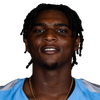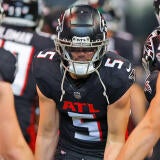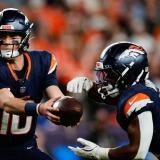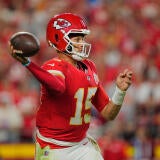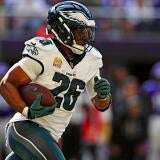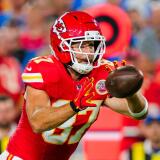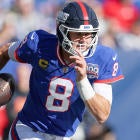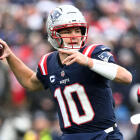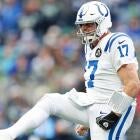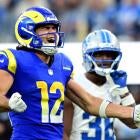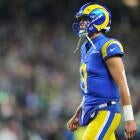
Giants release Daniel Jones: Exploring replacement options at quarterback in 2025 NFL Draft
Examining the failed Jones experiment and where the Giants can turn at the quarterback spot

It was inevitable and it finally happened.
The Giants are moving on from Daniel Jones, releasing the quarterback on Friday. Tommy DeVito had already been named the starter after New York benched Jones earlier in the week. Jones was given an incredibly long leash -- now 68 regular-season starts -- and the results have mostly been brutal. The 190-yard, zero-touchdown, two-interception, 50.5 rating performance in Munich in the loss to the lowly Panthers sealed the deal (if it wasn't already).
Jones has been just good enough to retain a starting gig. But he's rarely, if ever, the reason the Giants win games, and he'll likely finish his career as a Giant with a 24-44-1 record.
While Jones' inexplicable decisions and woefully inaccurate tosses likely resonate the most with all of us, it's often his narrow misses on easy throws that are the difference in completions, first downs and scores and incompletions and interceptions.
Take the second pick against the Panthers in Germany. The Giants were mounting an impressive fourth-quarter comeback when Jones made this slightly inaccurate throw into the flat to rookie running back Tyrone Tracy.
— Chris Trapasso (@trapassofilm) November 11, 2024
Those plays can't happen. Not if you're a well-paid NFL starting quarterback. And they embody the Jones era for the Giants. The largest recent misstep this organization made was handing Jones a four-year, $160 million contract with $82 million guaranteed at signing after the 2022 campaign in which New York won a playoff game in Minnesota.
And this is not hindsight being 20/20. In that debut season for GM Joe Schoen and head coach Brian Daboll, Jones did manage a respectable 92.5 rating during the regular season and arguably played his finest game in the playoff win in Minnesota, when he completed more than 68% of his 35 passes for 301 yards with two touchdowns and no interceptions.
But to get to the playoffs, Jones threw 15 touchdowns to five interceptions in the regular season and averaged fewer than 30 pass attempts per contest. The trademark of that season for Jones was that he kept himself from being the reason the Giants lost games. He had the lowest interception rate -- just 1.1% -- among qualifying quarterbacks that season.
While the money paid to Jones wasn't exorbitant, it tied the Giants to him for what will amount to two more seasons, and unsurprisingly, he hasn't been able to elevate those around him in a more prominent role in Daboll's offense. Since then, he has three contests with a 100-plus rating on 30-plus throws to six games with a rating under 75 when he's thrown it 30-plus times.
And what's bizarre about the Giants' decision to extend Jones after the 2022 campaign, Schoen had been in a nearly identical scenario in 2017 as a member of the Bills front office with Tyrod Taylor. Buffalo snapped a 17-year playoff drought with Taylor as the starter. Despite that, given Taylor's status as a low-volume game-manager type with dynamic athleticism, Buffalo decided to trade him to the Browns before selecting Josh Allen in the 2018 NFL Draft.
So where can the Giants go from here? Based on Hard Knocks, we know Schoen made a concerted effort to move to No. 3 overall in the 2024 NFL Draft to, presumably, select Drake Maye.
The 2025 class doesn't have a Caleb Williams, Jayden Daniels, or Maye-level prospect. At the three-quarter mark of this college football season, that appears to be evident.
Miami's Ward is probably the most fun prospect with NFL-caliber qualities. He has a 6.4% big-time throw rate (BTT) -- slightly ahead of Williams at USC in 2023 -- while completing close to 67% of his throws as a vertical-based passer (9.7 average depth of target). He doesn't have a seismic arm and hasn't been surgically accurate in his collegiate career but does have serious improvisational skills and loads of experience. He's currently in his fifth year as a starter at the college ranks.
Colorado's Sanders has the third-highest adjusted completion rate (81.9%) among qualifying FBS passers with a 5.4% to 1.2% BTT to turnover-worthy play ratio. He exudes pocket confidence and anticipatory throwing abilities. His arm is NFL-caliber. It's not a genuine strength to his profile. Sanders will have an abundance of experience too with close to 2,000 attempts to his name before turning pro.

Alabama's Jalen Milroe is the wild-card of the group. Boom or bust. He's arguably the most gifted athlete at the quarterback position to enter the NFL since Lamar Jackson -- and that is not forgetting Daniels -- and plays at a strapping 6-feet-2 and 225 pounds. The passing intricacy is still under construction, but his improvement is noticeable. Milroe's adjusted completion rate has improved in each of the past three seasons as his TWP rate has dropped.
Texas' Ewers is another project-y type, with the most live arm of the group. He'll have loads of big-game experience entering the NFL, having already played in last year's College Football Playoff and destined to make a deep run in the new expanded playoff this season. The former elite recruit hasn't progressed as expected as a passer, yet is capable of making every throw on the field and has gotten sleeker and faster throughout his time in Austin.
Those are the most likely contenders to be the Giants' next quarterback. None of them are sparkly prospects whose flaws are a challenge to find on film. However, that shouldn't, and likely won't, preclude New York from selecting one. And, heck, two of the most highly regarded quarterback prospects of the past five years -- Caleb Williams and Trevor Lawrence -- haven't exactly met expectations to date.
The Giants must thoroughly study the 2025 quarterback class and, if necessary, move mountains to select the passer they like most. Because the Jones experiment failed, and this organization cannot function properly in the NFC with him as the starting quarterback anymore.


